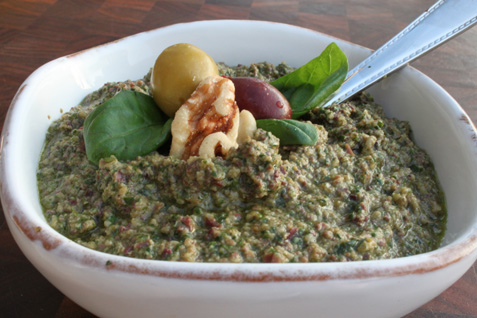
Pesto is one of those magical foods that can turn a ho-hum sandwich into a flavor-packed gourmet meal. Some people think that there is only one use for pesto…. pasta, and only one kind of pesto. I know at least a dozen! A plain grilled chicken cutlet or fish can be transformed with just one tablespoon of pesto! Countless vegetarian dishes with tofu or beans are brought to life as well with the incredible flavor boost that pesto provides. This keeps for a week in the fridge, or frozen for a few months. Freeze in an ice cube tray, then pop out the pesto cubes into an airtight freezer safe container. This will give you individual servings of pesto that defrost quickly as you need it.
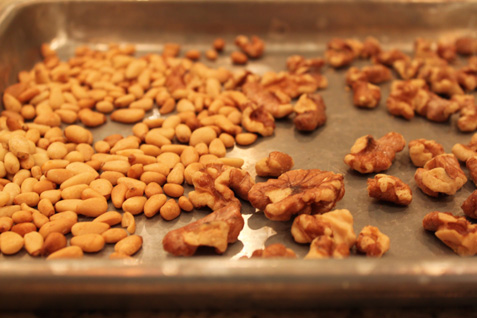
- 1 1/2 cup green Israeli or Spanish green olives, pitted, coarsely chopped
- 3/4 cup Kalamata Greek olive, pitted, coarsely chopped
- 1/2 cup walnuts, lightly toasted and coarsely chopped
- 1/4 cup pine nuts, lightly toasted and coarsely chopped
- 1 cup fresh basil leaves
- 2 tablespoons fresh parsley
- 3-4 cloves garlic, chopped
- 2 tablespoons fresh chives, sliced
- freshly ground black pepper, to taste
- 1 teaspoon lemon zest, freshly grated
- 1/2 cup extra-virgin olive oil; add more as needed
- sea salt to taste – optional (olives are very salty; add salt, as needed, with caution)
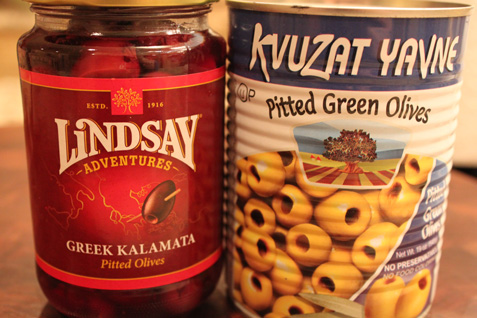
Mortar and Pestle Method:
Completely smash the garlic until it is a paste-like consistency prior to adding the other ingredients. Drizzle the oil in gradually after all of the other ingredients have been ground in the mortar.
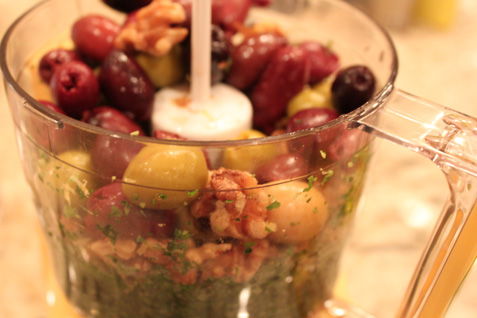
Food Processor Method:
This works best in a smaller food processor.
Add all the ingredients to the food processor, except for the oil and salt. Using a pulsing action, coarsely chop the mixture. When the ingredients have been completely blended, slowly drizzle the oil over the ingredients while the machine is still running, pulsing the machine, while being careful not to turn the mixture into a smooth paste. It should resemble a coarse paste with lots of texture. Scoop out the mixture adding salt to taste mixing well with a fork.
- 1½ cup green Israeli or Spanish green olives, pitted, coarsely chopped
- ¾ cup Kalamata Greek olive, pitted, coarsely chopped
- ½ cup walnuts, lightly toasted and coarsely chopped
- ¼ cup pine nuts, lightly toasted and coarsely chopped
- 1 cup fresh basil leaves
- 2 tablespoons fresh parsley
- 3-4 cloves garlic, chopped
- 2 tablespoons fresh chives, sliced
- freshly ground black pepper, to taste
- 1 teaspoon lemon zest, freshly grated
- ½ cup extra-virgin olive oil; add more as needed
- sea salt to taste - optional (olives are very salty; add salt, as needed, with caution)
- Mortar and pestle method:
- Completely smash the garlic until it is a paste-like consistency prior to adding the other ingredients. Drizzle the oil in gradually after all of the other ingredients have been ground in the mortar.
- Food processor method:
- This works best in a smaller food processor.
- Add all the ingredients to the food processor, except for the oil and salt. Using a pulsing action, coarsely chop the mixture. When the ingredients have been completely blended, slowly drizzle the oil over the ingredients while the machine is still running, pulsing the machine, while being careful not to turn the mixture into a smooth paste. It should resemble a coarse paste with lots of texture. Scoop out the mixture adding salt to taste mixing well with a fork.
- * Parve, non-dairy and vegetarian/vegan
- ** You can purchase pitted olives, use an olive pitter, or remove the pits by hitting the olives lightly with a chef's knife or rolling pin on a clean, dry counter top. I love my Good Grips brand olive pitter.
* Parve, non-dairy and vegetarian/vegan
** You can purchase pitted olives, use an olive pitter, or remove the pits by hitting the olives lightly with a chef’s knife or rolling pin on a clean, dry counter top. I love my Good Grips brand olive pitter.

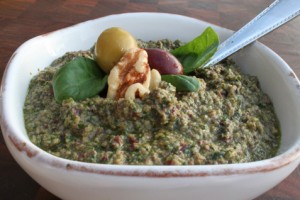
Leave a Reply